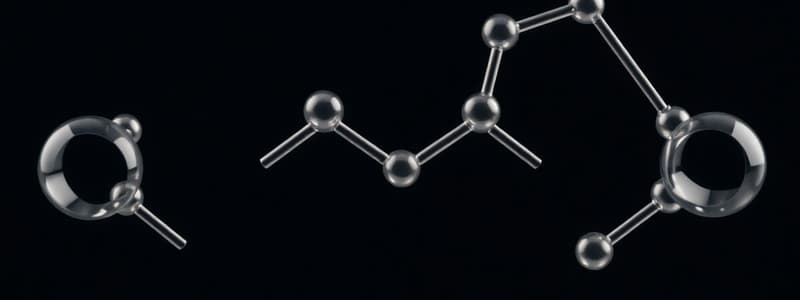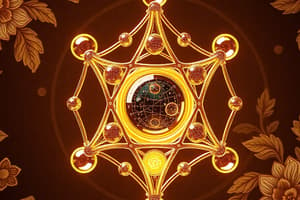Podcast
Questions and Answers
What intermolecular forces allow small ester molecules to be soluble in water?
What intermolecular forces allow small ester molecules to be soluble in water?
- Dipole-Dipole forces (correct)
- Hydrogen bonding
- London dispersion forces
- Ionic bonding
What is a characteristic feature of the bonding structure in benzene?
What is a characteristic feature of the bonding structure in benzene?
- Bond lengths between all carbon atoms are equal (correct)
- Carbon atoms have six valence electrons
- Each carbon forms two bonds with adjacent carbons
- All carbon bonds are double bonds
Which substance is classified as a natural organic compound?
Which substance is classified as a natural organic compound?
- Vanillin
- Eugenol (correct)
- Menthol (lab made)
- Ibuprofen
What is the function of anti-bumping granules in the steam generator during extraction?
What is the function of anti-bumping granules in the steam generator during extraction?
During steam distillation, what appearance is expected for the collected distillate?
During steam distillation, what appearance is expected for the collected distillate?
What type of intermolecular forces do ester molecules primarily possess?
What type of intermolecular forces do ester molecules primarily possess?
Which of the following best describes delocalized electrons in benzene?
Which of the following best describes delocalized electrons in benzene?
Which step is incorrect when setting up an experiment for steam distillation?
Which step is incorrect when setting up an experiment for steam distillation?
What is the boiling point of cyclohexane, which is relevant in the separation process of clove oil?
What is the boiling point of cyclohexane, which is relevant in the separation process of clove oil?
What is the function of anhydrous sodium sulfate in the extraction process?
What is the function of anhydrous sodium sulfate in the extraction process?
Which layer contains the clove oil and cyclohexane after liquid-liquid extraction?
Which layer contains the clove oil and cyclohexane after liquid-liquid extraction?
What should be done after shaking the mixture in the dropping funnel?
What should be done after shaking the mixture in the dropping funnel?
Which statement correctly describes an emulsion?
Which statement correctly describes an emulsion?
What is the expected yield when extracting clove oil using the described method?
What is the expected yield when extracting clove oil using the described method?
What safety precaution is emphasized regarding the clove oil during extraction?
What safety precaution is emphasized regarding the clove oil during extraction?
What is the role of a water bath in the evaporation of cyclohexane?
What is the role of a water bath in the evaporation of cyclohexane?
What characteristic defines a tetrahedral carbon?
What characteristic defines a tetrahedral carbon?
Which of the following compounds is classified as a chloroalkane?
Which of the following compounds is classified as a chloroalkane?
How are alcohols generally named?
How are alcohols generally named?
Which type of alcohol has the hydroxyl group attached to a carbon that is connected to only one other carbon atom?
Which type of alcohol has the hydroxyl group attached to a carbon that is connected to only one other carbon atom?
What is the general formula for alcohols?
What is the general formula for alcohols?
What is the primary use of chloroalkanes in practical applications?
What is the primary use of chloroalkanes in practical applications?
What happens to alcohol boiling points compared to their corresponding alkanes?
What happens to alcohol boiling points compared to their corresponding alkanes?
What is typically added to industrial ethanol to prevent consumption?
What is typically added to industrial ethanol to prevent consumption?
What type of bonding allows small alcohol molecules to be soluble in water?
What type of bonding allows small alcohol molecules to be soluble in water?
Which alcohol is likely to be soluble in water based on molecular size?
Which alcohol is likely to be soluble in water based on molecular size?
What chemical group is characteristic of ketones?
What chemical group is characteristic of ketones?
Which statement correctly describes the boiling points of aldehydes compared to alcohols?
Which statement correctly describes the boiling points of aldehydes compared to alcohols?
Which functional group is found in carboxylic acids?
Which functional group is found in carboxylic acids?
What happens to the solubility of carboxylic acids as the carbon chain length increases?
What happens to the solubility of carboxylic acids as the carbon chain length increases?
How are esters formed?
How are esters formed?
What is the naming convention for esters derived from ethanoic acid and methanol?
What is the naming convention for esters derived from ethanoic acid and methanol?
Which statement about the boiling points of carboxylic acids is true?
Which statement about the boiling points of carboxylic acids is true?
What is a defining characteristic of the carbonyl group in ketones?
What is a defining characteristic of the carbonyl group in ketones?
Flashcards
Ester intermolecular forces
Ester intermolecular forces
Ester molecules have dipole-dipole forces, which influence their solubility in water.
Solubility of small esters
Solubility of small esters
Small ester molecules are soluble in water due to their dipole-dipole intermolecular forces.
Ester uses in food
Ester uses in food
Esters are used to create fruity flavors in food.
Benzene carbon bonding
Benzene carbon bonding
Signup and view all the flashcards
Delocalized electrons in benzene
Delocalized electrons in benzene
Signup and view all the flashcards
Benzene carbon-carbon bonds
Benzene carbon-carbon bonds
Signup and view all the flashcards
Steam Distillation
Steam Distillation
Signup and view all the flashcards
Steam distillation apparatus setup
Steam distillation apparatus setup
Signup and view all the flashcards
Tetrahedral Carbon
Tetrahedral Carbon
Signup and view all the flashcards
Chloroalkane
Chloroalkane
Signup and view all the flashcards
Alcohol Functional Group
Alcohol Functional Group
Signup and view all the flashcards
Primary Alcohol
Primary Alcohol
Signup and view all the flashcards
Secondary Alcohol
Secondary Alcohol
Signup and view all the flashcards
Tertiary Alcohol
Tertiary Alcohol
Signup and view all the flashcards
Ethanol Use
Ethanol Use
Signup and view all the flashcards
Denatured Ethanol
Denatured Ethanol
Signup and view all the flashcards
Emulsion
Emulsion
Signup and view all the flashcards
Liquid-liquid extraction
Liquid-liquid extraction
Signup and view all the flashcards
Cyclohexane
Cyclohexane
Signup and view all the flashcards
Anhydrous sodium sulfate
Anhydrous sodium sulfate
Signup and view all the flashcards
Structural isomers
Structural isomers
Signup and view all the flashcards
Propan-2-ol
Propan-2-ol
Signup and view all the flashcards
Hydrogen bonding in alcohols
Hydrogen bonding in alcohols
Signup and view all the flashcards
Solubility of alcohols
Solubility of alcohols
Signup and view all the flashcards
Planar carbon
Planar carbon
Signup and view all the flashcards
Aldehyde functional group
Aldehyde functional group
Signup and view all the flashcards
Aldehyde properties
Aldehyde properties
Signup and view all the flashcards
Ketone functional group
Ketone functional group
Signup and view all the flashcards
Ketone properties
Ketone properties
Signup and view all the flashcards
Carboxylic acid functional group
Carboxylic acid functional group
Signup and view all the flashcards
Carboxylic acid properties
Carboxylic acid properties
Signup and view all the flashcards
Ester functional group
Ester functional group
Signup and view all the flashcards
Study Notes
Tetrahedral Compounds
- A tetrahedral carbon atom has four single bonds.
- A chloroalkane is a compound where one or more hydrogen atoms in an alkane are replaced by chlorine atoms.
- Chloroalkanes are used as solvents to remove grease and oil.
- Chloroalkanes are weakly polar and not soluble in water, but soluble in non-polar solvents like cyclohexane.
- Chloroalkanes are liquids at room temperature.
Alcohols
- A functional group is an atom or group of atoms responsible for the properties of an organic compound.
- Alcohols are derived from alkanes by replacing hydrogen with an -OH group (hydroxyl group).
- The general formula for alcohols is CnH2n+1OH
- Alcohols are named by changing the -e in the alkane name to -ol.
- Primary alcohol: the carbon atom bonded to the -OH group is attached to only one other carbon atom.
- Secondary alcohol: the carbon atom bonded to the -OH group is attached to two other carbon atoms.
- Tertiary alcohol: the carbon atom bonded to the -OH group is attached to three other carbon atoms.
- Alcohols generally have higher boiling points than alkanes due to hydrogen bonding between the molecules.
- Smaller alcohols are soluble in water due to hydrogen bonding, larger ones are less soluble.
Planar Compounds
- A planar carbon atom has planar geometry.
- This occurs when the carbon atom is unsaturated (contains a double or triple bond).
Aldehydes
- Aldehydes contain the -CHO functional group.
- They are named by changing the -e in the parent alkane name to -al.
- They have higher boiling points than their corresponding alkanes due to dipole-dipole forces.
- Boiling points are lower compared to their corresponding alcohols.
Ketones
- Ketones contain the >C=O functional group.
- Named by changing the final -e to -one in the parent alkane name.
- The C=O carbonyl group is always located on the central carbon.
- Boiling points generally are higher than their corresponding alkanes due to dipole-dipole forces.
- Boiling points are lower than alcohols. Small ketones are soluble in water.
Carboxylic Acids
- Carboxylic acids contain the -COOH functional group (carboxyl group).
- Named by changing the final -e to -oic acid in the parent alkane name.
- The C=O carbonyl group is located at the end of the carbon chain.
- Higher boiling points in comparison to alkanes, alcohols, aldehydes and ketones due to strong hydrogen bonds between molecules
- Small carboxylic acids are soluble in water.
Esters
- Esters have the general formula RCOOR' and the functional group -COO-.
- Formed from carboxylic acids and alcohols with removal of water (condensation reaction).
- Named by naming the alkyl group of the alcohol first, then the part of the acid with 'oate' replacing '-oic acid'.
- Small ester molecules are soluble in water due to dipole-dipole intermolecular forces.
- Esters are often used in fruity/pleasant smelling substances, perfumes and flavourings.
Aromatic Compounds (Bonding in benzene)
- Each carbon atom in the benzene ring has four electrons.
- Carbon atoms use three electrons to form sigma bonds via head-on overlap.
- The fourth electron (and the fourth electron of each adjacent carbon atom) is delocalised around the ring of six carbon atoms.
- Delocalisation increases stability in the benzene ring.
- Bond lengths between all carbon atoms on the benzene ring are equal.
Organic Natural Products
- Many organically derived compounds are found in nature.
- Some examples include eugenol, vanillin, menthol, ibuprofen.
Steam Distillation
- Steam distillation is a method used to separate compounds with boiling points below their decomposition temperature.
- It involves bubbling steam through the material, followed by distilling off the liquid composition.
- The method is suited to separating immiscible liquids.
Liquid-Liquid Extraction
- A process to separate a substance from a mixture containing immiscible liquids using solvent extraction.
Studying That Suits You
Use AI to generate personalized quizzes and flashcards to suit your learning preferences.
Related Documents
Description
This quiz focuses on the characteristics and properties of tetrahedral compounds, particularly chloroalkanes and alcohols. Test your understanding of functional groups and the distinctions between primary, secondary, and tertiary alcohols along with their chemical formulas and applications.




